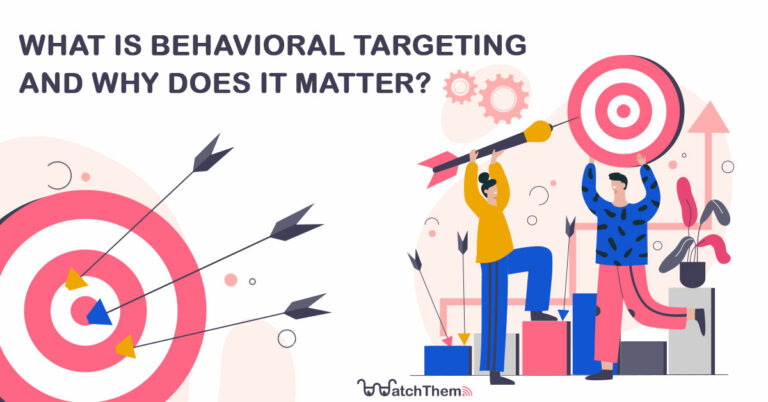Page Contents
Are you wondering what behavioral targeting is? Imagine that you are thinking of going vegan for a while; you do some research, watch some videos on YouTube, then suddenly you see vegan product ads everywhere after a few days. Why is this happening? That’s what we call behavioral targeting. Companies collect data from your online actions to show ads that you would be more interested in.
I’m sure you have had many similar experiences. But what exactly is behavioral targeting? How are companies personalizing their ads, and why so many apply this method in their marketing strategy?
Continue reading this article to find out the answers to these questions and much more.


What Is Behavioral Targeting?
Behavioral targeting is an advertising method that uses data collected from users’ activities throughout the web to show them relevant advertisements.
Today companies have access to user data like never before, which enables them to show users more relevant and personalized ads. The information marketers collect from users’ online behavior helps them improve their advertising campaings’ outcome. When people see ads that align with their habits and interests, they are more likely to purchase the advertised products. This means that behavioral targeting can help businesses increase their conversion rate considerably.
The data collected by businesses includes:
- Visited pages
- Searched terms
- Purchases
- The amount of time spent on a website
- Clicked links and ads
Behavioral targeting aims to use this information to reach users who are more likely to be interested in the advertising message.
Why Is Behavioral Targeting Important?
Before behavioral targeting became popular, many companies used contextual targeting to display their ads. This targeting method shows ads based on their relevance to the content on the page without using any information about the visitors. However, many marketers changed their advertising strategies after tracking user behavior became available.
While contextual targeting is still relevant in some cases, behavioral targeting is widely used because of its advantages. However, the problem with contextual targeting is that marketers are never sure if their message will reach the right people. As a result, even the most carefully created advertising messages can fail, wasting all their efforts.
On the other hand, ads displayed through behavioral targeting tend to engage users more effectively and create a better user experience.
This is why this targeting method is crucial: it benefits both users and companies.
Online Behavioral Targeting vs. Contextual Targeting
Ads related to the page’s content are displayed using contextual targeting. Typically, this kind of targeting does not involve user information; instead, it relies solely on the ad’s context. On the other hand, behavioral data can improve the relevancy of contextual adverts.
Advertisers and marketers can target specific consumers via online behavioral targeting. The strategy is founded on the idea that the ad should be relevant to the user visiting the website rather than the page itself. Because of the increased availability of user data, behavioral targeting has been widely employed in internet marketing for over a decade.


Pros and Cons of Behavioral Targeting
We know the importance of behavioral targeting, so now let’s explore some of its advantages and disadvantages.


Pros of Behavioral Targeting
Below you can find some advantages of this targeting method:
1- Higher Click-through Rate
Personalized ads are more likely to capture the users’ attention. As a result, users are more willing to engage with them, to look for more information.
2- Higher Conversion Rate
This is a direct result of the increase in the ad click-through number. Furthermore, behavioral targeting makes retargeting more effective. Retargeting ads are a reminder for your products and services to the users who have left your website without making a purchase. A retargeting campaign can be annoying if it’s irrelevant. People would rather see something relevant pop up the next time they visit a website.
3- Great Ad Efficiency
When ads are personalized, you no longer need to take steps to draw the users’ interests. Since people are already attracted to your advertising messages, the whole process will be so much quicker.
4- Better User Experience
No one likes to see irrelevant messages constantly showing up during their online activities. Displaying ads based on customer behavior analytics creates a more pleasant experience for customers.
Cons of Behavioral Targeting
Now, here are some disadvantages of this marketing method:
1- Invasion of Privacy
While personalized ads are usually well-received by customers, they can sometimes have a negative impact. If the behavioral data is not used carefully, users may feel like their privacy is being violated. As a result, many people are now using ad blockers.
2- Lack of Audience Knowledge
The key to success in behavioral advertising is having a deep knowledge of your audience. If you don’t know what your audience resonates with, your messages won’t capture their attention, and you will be wasting your resources. You may have the most accurate data, but it’s up to you to make use of them effectively. To improve the performance of advertising campaigns, you need to be up-to-date on how your audience is engaging with your ads.
3- The Exploitation of Personal Data
Exploitation of personal data is the biggest problem with behavioral targeting. With all the personal data we are sharing these days, there is always the fear of data exploitation, or worse, data breaches. There are even many critics who argue that behavioral advertising should be illegal.
4- Over-Advertising
Behavioral marketing is a great way to build brand familiarity, but you must avoid crossing the line and causing content overload. For example, if people see ads from your company every minute, they will start to ignore your messages.
Types of Behavioral Targeting
The two main types of behavioral targeting are onsite and network.
1- Onsite
Onsite behavioral advertising is the process of personalizing a particular website for its visitors. In this method, advertisers display ads, product recommendations, and relevant content based on the collected data from the users’ behavior on the website. Businesses implement this strategy to make their website as engaging as possible for each user. This way, viewers will spend more time on the site. It is also an excellent strategy for conversion rate optimization.
WatchThemLive’s user tracking service can be very beneficial in this specific case. Our user tracking service will follow your audience at each step and gather valuable information about their desires. You can find out your website’s impression on them and how they react to it. Therefore, you will make complex decisions for each case and make the experience more personalized for users.
Need help increasing your conversion rate? WatchThemLive is here to the rescue! Check out the plans, choose the one that best suits your needs, and get your free trial.
2- Network
Network behavioral targeting uses the information collected from the users’ behavior across the web to categorize them based on factors like interests and purchases. The data used in this method is mainly gathered from the advertiser’s website.
This information includes cookies and IP or Mac addresses, but not data like names, telephone numbers, and email addresses. Algorithms process all the collected data to assign users to segments like age, gender, interests, etc. This way, marketers can display user-specific and personalized retargeting ads.
Conclusion
Behavioral targeting utilizes data gathered from users’ web behavior to show them the most relevant advertisements. This technique has many advantages over other targeting methods, and it has become trendy. However, users can consider it a privacy invation if not applied carefully. Moreover, a deep knowledge of the audience is necessary to achieve the best results from this marketing technique.

